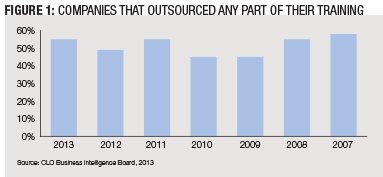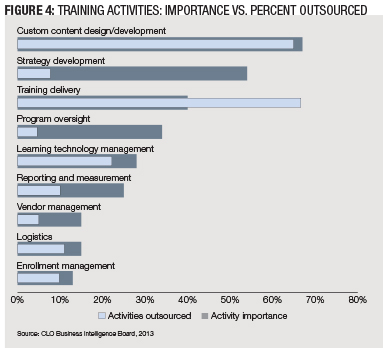Companies consistently need effective learning programs to transfer knowledge and skills to employees, customers and partners, to retain employees and to improve speed to proficiency. But the approach to develop knowledge transfer capability can vary between organizations. Learning programs can be grown organically over time, developed in-house, outsourced to a learning provider or implemented using some combination of in-house and external expertise.
The decision to outsource rests often on the volume and quality that internal staff can support.
Every other month IDC surveys Chief Learning Officer magazine’s Business Intelligence Board on a variety of topics to measure senior learning executives’ attitudes, issues and interests. More than 900 members shared their plans, objectives and feelings on learning outsourcing.
Overall, enterprises that outsource learning are satisfied with outsourcing and expect to maintain or increase spending levels for 2014. Some 50 percent of enterprises use an outside provider to augment some part of their learning function. Most often, enterprises use external vendors for content development, learning delivery and learning technology management.
Outsourcing’s Fluctuating Use
In the past several years, there has generally been a decline in the number of enterprises that outsource part of their learning function. In 2007, 58 percent of enterprises outsourced some portion of their learning process. By 2010, 45 percent of CLOs reported the same. Results from the 2013 survey indicate the trend appears to have stabilized at about 55 percent of enterprises that report outsourcing some portion of their learning function for the past two years (Figure 1). It is likely the dip in 2010 was a reaction to the global financial crisis as organizations reduced learning expenses dramatically, and in some cases did not renew outsource arrangements.

While the challenging economy was a significant driver for instability, it is likely an equally large driver for the recovery. As companies begin to recover, learning’s urgency rebounds. Enterprises leverage external providers to deliver more learning than internal resources can provide while gaining access to better learning expertise and controlling costs.
Most companies outsource only portions of their learning functions — only about 4 percent outsource the entire learning function. This percentage has remained relatively constant, even while the percentage of enterprises outsourcing only portions of their learning function declined and then recovered. Outsourcing the full learning function is not a decision that is quickly made. Further, most organizations are satisfied with their outsource arrangements, which provides little incentive to radically change their use of outsourcing.
Seventy-two percent of enterprises that outsource some portion of their learning spend less than 40 percent of their learning budget on outsourcing, and 30 percent spend less than 10 percent (Figure 2).

For 2014, 36 percent of companies expect spending on learning outsourcing to increase, which is a significant decline from last year’s results (Figure 3). This suggests companies that are outsourcing are relatively satisfied with their external learning providers. While the economic challenges have not fully retreated, only 17 percent of companies indicated their learning outsourcing budgets will decrease next year — down slightly from 18 percent in 2012.

Companies Outsource Important Activities
Some analysts and experts expect enterprises to outsource only non-core activities. However, CLOs seem willing to outsource both core and non-core activities. The activities that CLOs identify as most important include custom content design and development and learning delivery. Also important are strategy development, program oversight and learning technology management.
The importance of various learning activities hasn’t changed much in the past several years, suggesting overall priorities haven’t changed much, either. Figure 4 compares the importance of learning functions with the learning functions most frequently outsourced. Learning functions that are highly important but require a transfer of management responsibilities to execute, such as strategy development, program oversight and reporting and measurement, show a low popularity for outsourcing.

It seems that companies use external learning providers primarily for activities that are important but do not require the transfer of management authority.
While other aspects of learning outsourcing have not changed much, the reasons companies outsource have shown a significant shift. As recently as 2007, “speed to market” was a significant rationale to use external providers, but during the past several years its importance has declined. While organizations seek to rebound quickly from the economic crisis, they are less likely to leverage external vendors to get essential learning delivered quickly.
Companies more often leverage outsourcing to supplement internal resources and have learning resources available as needed. Increasingly, organizations believe that learning outsourcing is a more cost-effective method to create or deliver learning.
CLOs cited the need for specific skills and specialized knowledge. One respondent uses outsourcers to satisfy “native language needs in German, French, Korean and Chinese.” Another believes leveraging outsourcers for learning delivery allows her to “use internal resources for higher-level tasks; moving out the administrative where possible.”
CLOs also articulated two recurring themes for the use of outsource learning providers: “Head count reductions forced us to seek outside assistance,” and there is “no time for resources internally to develop learning.”
When given a choice on whether to outsource or hire additional resources, 50 percent of CLOs think outsourcing is more cost-effective and more flexible than hiring internal resources. One CLO believes that, “learning needs are constantly changing. In-house expertise becomes static and confined to specific areas.”
Those who outsource seem to be satisfied with their providers but less so than several years ago. While the percentage of CLOs who report being satisfied — either very or somewhat satisfied — with their providers overall is relatively high, there is a long-term trend that suggests satisfaction is declining. This year, 74 percent of enterprises report being satisfied with their providers, a slight decrease from 2012. However, the Net Promoter Score — the net dissatisfied subtracted from the net satisfied — showed a declining trend from 2007 (Figure 5).

The most important qualities CLOs consider when looking for a learning outsourcer are learning expertise and subject matter expertise. These are the fundamentals to provide high-quality learning services and to impart knowledge to the audience. This is also reflected by the increased importance CLOs placed on providers that have industry-specific knowledge.
Also important is the vendors’ ability to act as business partner. This reflects CLOs’ increased understanding of the fluid nature of learning objectives and the mutual flexibility that successful learning outsourcing arrangements require. It is also important that vendor and company are a cultural fit. CLOs report that good learning initiatives go bad when the learning provider’s culture can’t mesh with the learner population.
Who Are the Decision-Makers?
From 2006 to 2007 HR executives became more active in outsourcing decision-making — even more so than the CLO. More recently, however, CLOs and head of business units have taken on more decision-making authority for learning outsourcing across companies.
Companies that don’t outsource typically cite satisfaction with their internal learning operations or believe it is too expensive or the subject matter is too complex for outside providers. These reasons have been consistently important for the past six years of this survey. As one respondent put it, “Quality and knowledge matters a lot.
To keep it consistent and readily available I prefer to keep learning internal.” Another CLO thought internal learning delivery adds flexibility: “We customize our programs to meet our exact needs of our employees as well as the organization.”
Organizations approach knowledge transfer capability differently based on internal capability, hire external capability or a mix of the two. Not surprisingly, the reasons for outsourcing — access to capability and knowledge — are equally important for those who don’t outsource.
As enterprises continue to emerge from the economic crisis, external provider use will change. Some organizations will attempt to save money by increasing their use of external providers. Others will attempt to do more with less on their own, both believing their approach is the best one available. But whatever organizations do, aligning their learning offerings with the business needs seems to be job one.
Cushing Anderson is program director for learning services at IDC. He can be reached at editor@CLOmedia.com.















